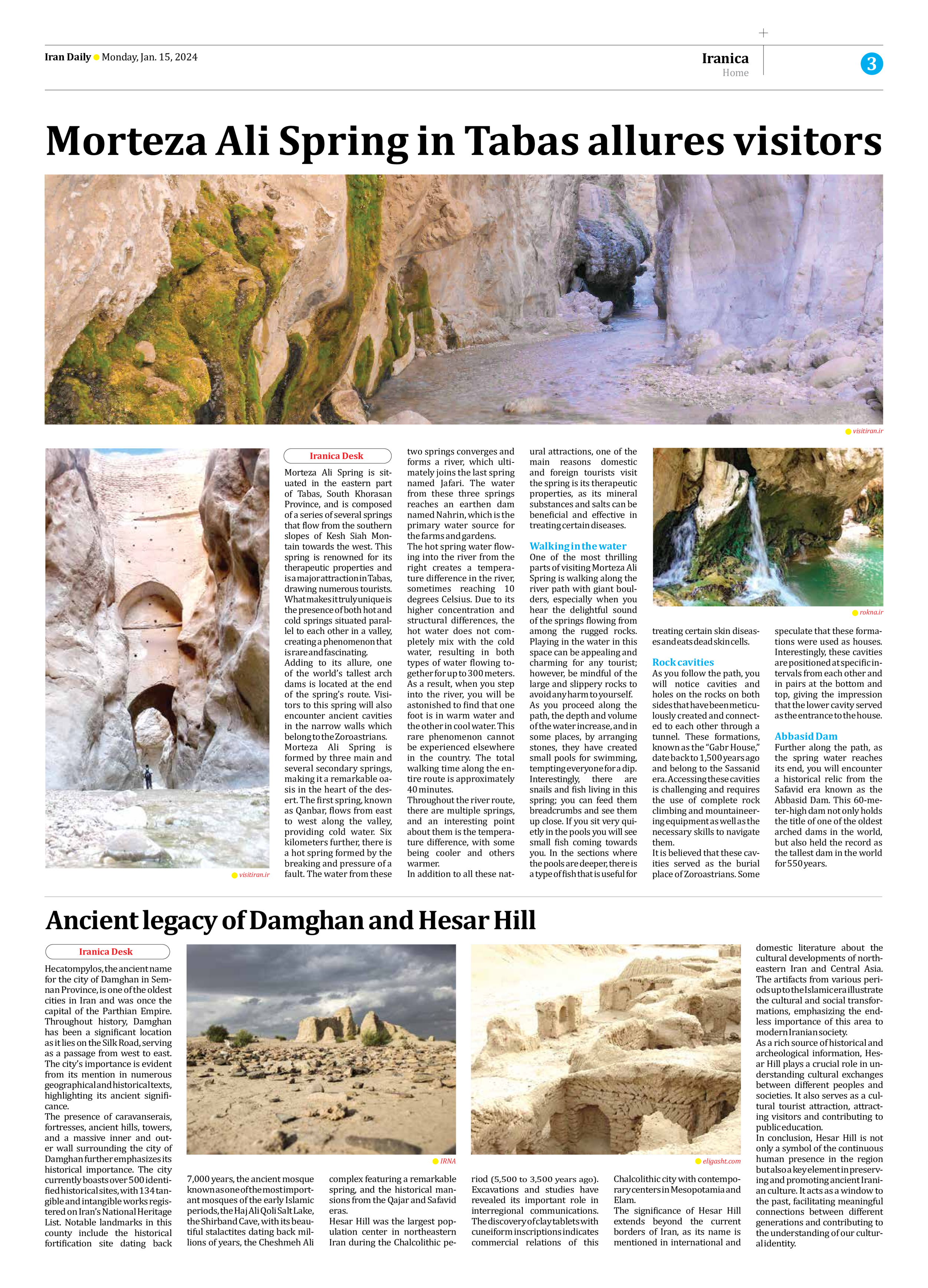
Morteza Ali Spring in Tabas allures visitors
Morteza Ali Spring is situated in the eastern part of Tabas, South Khorasan Province, and is composed of a series of several springs that flow from the southern slopes of Kesh Siah Montain towards the west. This spring is renowned for its therapeutic properties and is a major attraction in Tabas, drawing numerous tourists. What makes it truly unique is the presence of both hot and cold springs situated parallel to each other in a valley, creating a phenomenon that is rare and fascinating.
Adding to its allure, one of the world’s tallest arch dams is located at the end of the spring’s route. Visitors to this spring will also encounter ancient cavities in the narrow walls which belong to the Zoroastrians.
Morteza Ali Spring is formed by three main and several secondary springs, making it a remarkable oasis in the heart of the desert. The first spring, known as Qanbar, flows from east to west along the valley, providing cold water. Six kilometers further, there is a hot spring formed by the breaking and pressure of a fault. The water from these two springs converges and forms a river, which ultimately joins the last spring named Jafari. The water from these three springs reaches an earthen dam named Nahrin, which is the primary water source for the farms and gardens.
The hot spring water flowing into the river from the right creates a temperature difference in the river, sometimes reaching 10 degrees Celsius. Due to its higher concentration and structural differences, the hot water does not completely mix with the cold water, resulting in both types of water flowing together for up to 300 meters. As a result, when you step into the river, you will be astonished to find that one foot is in warm water and the other in cool water. This rare phenomenon cannot be experienced elsewhere in the country. The total walking time along the entire route is approximately 40 minutes.
Throughout the river route, there are multiple springs, and an interesting point about them is the temperature difference, with some being cooler and others warmer.
In addition to all these natural attractions, one of the main reasons domestic and foreign tourists visit the spring is its therapeutic properties, as its mineral substances and salts can be beneficial and effective in treating certain diseases.
Walking in the water
One of the most thrilling parts of visiting Morteza Ali Spring is walking along the river path with giant boulders, especially when you hear the delightful sound of the springs flowing from among the rugged rocks. Playing in the water in this space can be appealing and charming for any tourist; however, be mindful of the large and slippery rocks to avoid any harm to yourself.
As you proceed along the path, the depth and volume of the water increase, and in some places, by arranging stones, they have created small pools for swimming, tempting everyone for a dip.
Interestingly, there are snails and fish living in this spring; you can feed them breadcrumbs and see them up close. If you sit very quietly in the pools you will see small fish coming towards you. In the sections where the pools are deeper, there is a type of fish that is useful for treating certain skin diseases and eats dead skin cells.
Rock cavities
As you follow the path, you will notice cavities and holes on the rocks on both sides that have been meticulously created and connected to each other through a tunnel. These formations, known as the “Gabr House,” date back to 1,500 years ago and belong to the Sassanid era. Accessing these cavities is challenging and requires the use of complete rock climbing and mountaineering equipment as well as the necessary skills to navigate them.
It is believed that these cavities served as the burial place of Zoroastrians. Some speculate that these formations were used as houses. Interestingly, these cavities are positioned at specific intervals from each other and in pairs at the bottom and top, giving the impression that the lower cavity served as the entrance to the house.
Abbasid Dam
Further along the path, as the spring water reaches its end, you will encounter a historical relic from the Safavid era known as the Abbasid Dam. This 60-meter-high dam not only holds the title of one of the oldest arched dams in the world, but also held the record as the tallest dam in the world for 550 years.







